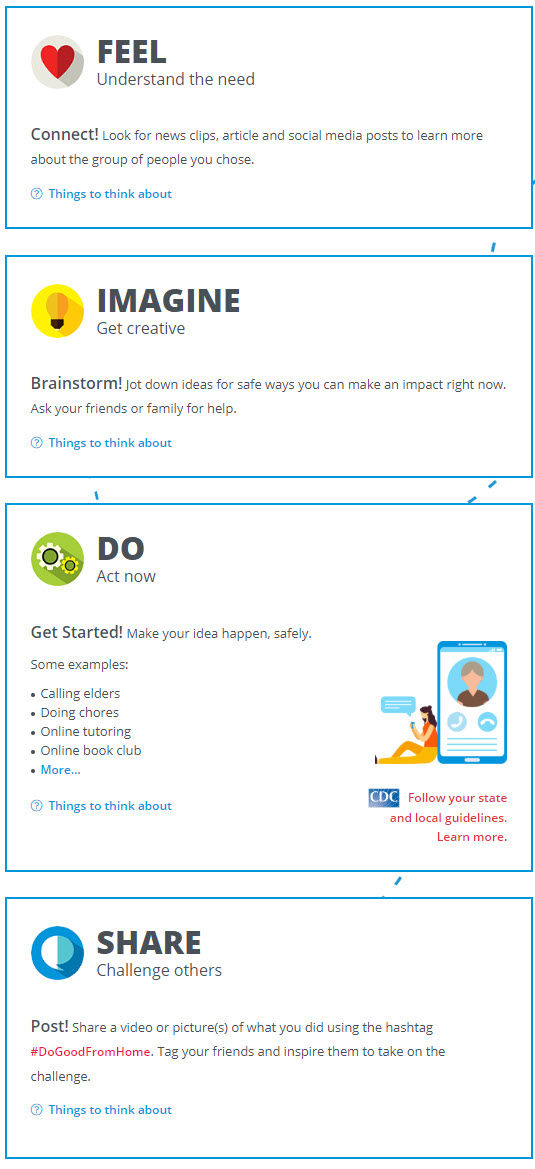Empathy
Youth Respond With Kindness During the Pandemic
Four steps that turn empathy into compassionate action.
Posted April 1, 2020

Everyone knows that adversity can bring out the best in people. With schools closed across the country, many students are responding in innovative ways to show empathy and compassion for others.
What is important for educators and parents to understand is that doing simple acts of kindness can reap big developmental rewards for young people, including growth in empathy, self-awareness, resourcefulness, and resilience. But the kind action itself is only one small part of the learning process.
When parents and educators understand how empathy is psychologically channeled into compassionate action, children benefit.
Design for Change USA is a nonprofit with a powerful framework that helps children learn empathy in ways their brains are designed to learn—through relational experiences.
Simply put, relational experiences involve deep emotional connections and involve multiple ways of interacting. Often, relational experiences are life-changing, touching children in ways they remember for many years to come.
Conversely, transactional experiences achieve short-term results and require little emotion. While both types of experiences are part of teaching and learning, empathy can only be taught through the practice and power of relational experiences.
The Design for Change framework was first developed and launched in India by award-winning educator Kiran Bir Sethi. Partnering with experts from the Stanford Design School and IDEO, she launched a movement that helped children experience empathy in new ways. Using the FIDS framework (feel, imagine, do, share), more than 2 million young people in 65 countries are not only practicing empathy, but turning empathy into action.
From Empathy Warmups, to Design Sprints, to full Community Action projects, the FIDS framework is used in American classrooms and after-school programs with teacher flexibility. Yet, the model is so simple, parents or distance-learning educators can use it with students at home to help them experience empathy and spark creative acts of kindness.
How can you use the FIDS framework at home? In times of crisis—during COVID-19 school closures, when a friend is struggling, a family member is ill, or a neighbor needs help—adults can engage kids with the FIDS framework to make a difference.
The #DoGoodFromHome Challenge
In response to the COVID-19 crisis, Design for Change USA recently launched The #DoGoodFromHome Challenge. It’s a model for how kids can experience a simplified version of FIDS right from home. Whether responding to COVID-19 or to other needs in a child’s family or community, kids can not only make a difference, but they can internalize and learn from their acts of kindness.
These are the four simple steps, courtesy of Design for Change USA:

Four Steps That Turn Empathy Into Action
The Design for Change framework was created for teams of students that work together on school or community projects. But parents and online educators can easily use the simplified framework above to help children practice empathy from home. When you help children move through the four steps of feel, imagine, do, share, you help them cultivate essential abilities for thriving in life.
1. Feel
In the FIDS process, empathy (feel) comes first. Sharing how you feel (modeling) and inviting kids to share how they feel is a critical part of healthy parent-child relationships. Practicing empathy in this way is how family members learn to understand each other. If your family hasn’t yet adopted a routine of having family meetings, these can provide a great opportunity to share feelings and check-in about people who may need help.
In The #DoGoodFromHome Challenge, the “feeling” stage involves understanding others’ needs. For example, in the COVID-19 crisis, your child’s relational connection to elderly grandparents might motivate your child to feel deeply for elderly neighbors. Whatever the situation, children will feel empathy for others based on their own relational experiences in life. When parents initiate conversations that help children better understand other’s needs, they help kids put themselves into other people’s shoes.
2. Imagine
The process of imagining gives kids a voice and sparks their creativity. It says to them, “Your feelings and ideas are important. You have the power to help.” While you may have many ideas about how your kids can or should help others, this step is not about parental creativity. It is about your son’s ability to imagine how he is moved to help. It is about your daughter’s ability to respond to the suffering of others without being told how. When your child has brainstormed ideas and decided how he/she most wants to respond, ask how you and other family members can assist. Let your child take the lead!
3. Do
The third step involves action. Perhaps your daughter decided to write notes to elderly people in nursing homes during the COVID-19 crisis. Maybe your son offered to cut a neighbor’s lawn when that neighbor broke his leg. The situations and ideas are endless. When kids take action motivated by their own feelings and imagination, they experience the power of feeling resourceful. They learn to believe in themselves.
4. Share
The last step is to share with others. Why? At first glance, you might ask, “Isn’t it enough to ‘do’ caring acts without the need for external recognition?” Indeed, that is the goal. With lots of relational and empathetic practice, children grow to be caring adults. Caring becomes part of who they are on the inside, regardless of outward rewards.
The Design for Change framework asks kids to share their work for several important reasons. First, sharing stories generates awareness and inspires other kids to learn. For example, the #DoGoodFromHome Challenge is being shared on social media to inspire other children to do simple acts of kindness during a globally challenging time.
Lastly, the most important reason to share is to reflect on learning. To share with others, even with one’s own family, a child must be able to tell a story—the story of “how I felt, what I imagined I could do, and what I did.” To tell a story, your child must reflect on the process. This improves self-awareness and helps children link their initial feelings of empathy with how they responded. These kinds of stories generate learning and give children a process they can draw upon throughout life.
Design Thinking
The FIDS framework is based on design thinking, a human-centered, innovative process used to address a vast range of challenges, from product design to solving societal problems. This way of thinking has helped educators teach empathy to children around the world by inviting them to become problem-solvers and innovators. Students become the designers of change and the changemakers. They learn how to transform empathy into action.
This brilliant four-step framework from Design for Change is easy to remember as parents and educators make caring a priority in homes and classrooms.
Learn about Design for Change USA program here.




